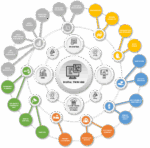
Floating Water Platforms: Construction & Uses
Although most modern construction takes place on dry land, sometimes building on top of water has its benefits too. Floating platforms form the basis of on-water construction, which can be used for a variety of purposes.
Types of Floating Platforms
Whether you’re looking for moderate or deep water applications, there are floating platform construction models designed to suit a variety of industries.
- Spar Platforms – suitable for harsh environments with ice and cold temperatures
- Semi-Submersible Platforms – suitable for mid-range and deep water production and drilling
- Tensioned Leg Platforms – suitable for supporting dry trees and is cost effective
- Extendable Draft Platforms – suitable for ocean science measurements and hydraulic power
On-Water Construction
Unlike large ships and barges, floating platforms can be stably constructed without ballasting or using an excess of materials. These structures have low buoyancy, which makes them cost-effective but limits the loads that they can hold. Some projects require more buoyancy, and for those, tanks can be added to the sides and cavities. It’s important that on-water construction projects can withstand high winds and waves in case of hurricanes and other storms.
Power Platforms
The most common use for offshore construction is to produce and transmit gas, electricity, and oil. Some engineers fully construct the facility on land and then tow the structure out to the water. Modular construction is often used to construct individual pieces of the platform on shore and then lift them into place with a crane.
Oil platforms are typically fixed installations that remain in key locations. Related floating vessels include drilling rigs for deep water extraction and jack-up floating designs that include a barge with legs. When floating platform construction requires extensive labor, floating hotel vessels are used to accommodate workers.
Wind Power and Electricity
In the U.S., wind power has emerged as a very promising source of electricity. The U.S. Energy Information Administration reported that 30 percent of new generating capacity over the last five years was attributed to wind turbines.
Offshore wind turbines require engineers to design floating platforms that are tethered to the ocean’s floor. Off the coast of Fukushima, Japan, engineers are using $232 million of government dollars to build a deep water platform with wind turbines. To help stabilize the platform, engineers added more bolts to prevent sway, added more transformer oil, and raised the oil tank height.
“We believe that a downwind design will have particular advantages for a wind turbine mounted on a floating platform that is subject to tilting, such as higher generation efficiency” wrote Mitsuru Saeki, Hitachi senior project manager, who also pointed out that downwind turbines track changes in wind angles when they blow from the side.
Residential Real Estate
Living near or even on the water is a big perk for many homeowners, so floating platforms also have a place in residential real estate. Experienced construction companies can create building foundations, gangway platforms, ferry landings, fuel stations, and housing structures on the water.
Concrete floats are popular to use as support structures for floating homes because of concrete’s strength and stability. Just as with any home construction process, concrete floats must also be level, buoyant, varmint-free, and have in-floor heating and insulation. Most floating home platforms are built in a depth of about five feet, although they typically need only about three feet to float. Floating platforms can even be used for large venues, such as The Float at Marina Bay in Singapore, which is used for concert performances and exhibitions.
Photo credit: McDermott International, Inc. and Shankar S. via Flickr



